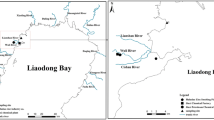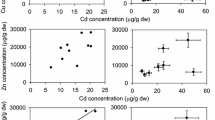Abstract
Cadmium (Cd), copper (Cu), mercury (Hg), lead (Pb), and zinc (Zn) were assessed in the edible tissues of Crassrotrea corteziensis oysters collected during the rainy and dry seasons in 27 sites from 8 coastal lagoons of the southeast Gulf of California. In addition, C. palmula oysters were sampled at 9 sites from the same mangrove roots where C. corteziensis oysters were collected. Metal analyses were performed by flame atomic absorption spectrophotometry (Cd, Cu, and Zn), graphite furnace (Pb), and cold vapor detection (Hg). The obtained mean levels were (µg g−1 dry weight) as follows: Cd 6.05 ± 2.77, Cu 60.0 ± 33.4, Hg 0.38 ± 0.17, Pb 1.11 ± 0.63, and Zn 777 ± 528 µg g−1. For all metals except Hg, the concentrations were greater during dry season than during rainy seasons. The high levels, particularly that for Cd, were related to upwelling along the eastern Gulf of California. High Hg levels in the rainy season were associated with the transport of materials from the watershed to the lagoon. Shrimp farming, agriculture, and other sources were considered as potential sources to explain the differences in metal bioavailability in the 8 lagoons. The mean concentrations of Cd (Santa María-La Reforma lagoon), Cu [San Ignacio–Navachiste–El Macapule (SINM), Urías (URI), and Altata-Ensenada del Pabellón lagoons], and zinc (Zn) (URI, Santa María–Ohuira–Topolobampo, El Colorado, and SINM lagoons) during the dry season were greater than the maximum permissible limits. C. palmula collected in 8 sites where they were present simultaneously with C. corteziensis had consistently greater metal levels than C. corteziensis, but correlation analyses showed a high and significant (P < 0.05) correlation between metal concentrations in both species. The correlation equations obtained are useful where the same species is not distributed and is necessary to compare results from distinct regions.



Similar content being viewed by others

References
Affizah N, Vedamanikam VJ, Shazilli NAM (2009) Concentration of arsenic and mercury in the oyster (Crassostrea iredalei) from Setiu lagoon, Terengganu. Toxicol Environ Chem 91:259–265
Alfonso JA, Handt H, Mora A, Vásquez Y, Azocar J, Marcano E (2013) Temporal distribution of heavy metal concentrations in oysters Crassostrea rhizophorae from the central Venezuela coast. Mar Pollut Bull 73:394–398
Azlisham M, Vedamanikam VJ, Shazilli NAM (2009) Concentrations of cadmium, manganese, copper, zinc, and lead in the tissues of the oyster (Crassostrea iredalei) obtained from Setiu Lagoon, Terengganu, Malaysia. Toxicol Environ Chem 91:251–258
Bayen S (2012) Occurrence, bioavailability and toxic effects of trace metals and organic contaminants in mangrove ecosystems: a review. Environ Int 48:84–101
Chávez-Villalba J, López-Tapia M, Mazón-Suástegui J, Robles-Mungaray M (2005) Growth of the oyster Crassostrea corteziensis (Hertlein 1951) in Sonora, Mexico. Aquac Res 36:1337–1344
Comisión Nacional del Agua Servicio Meteorológico Nacional (2005) Datos estadísticos climáticos del observatorio meteorológico de Mazatlán, Sinaloa, México [in Spanish]. CNA
Costa BGB, Soares TM, Torres RF, Lacerda LD (2013) Mercury distribution in a mangrove tidal creek affected by intensive shrimp farming. Bull Environ Contam Toxicol 90:537–541
Frías-Espericueta MG, Osuna-López JI, Flores-Reyes S, López-López G, Izaguirre-Fierro G (2005) Heavy metals in the oyster Crassostrea corteziensis from Urías lagoon, Mazatlan, Mexico, associated with different anthropogenic discharges. Bull Environ Contam Toxicol 74:996–1002
Frías-Espericueta MG, Osuna-López JI, Bañuelos-Vargas I, López-López G, Muy-Rangel MD, Izaguirre-Fierro G et al (2009) Cadmium, copper, lead and zinc contents of the mangrove oyster, Crassostrea corteziensis, of seven coastal lagoons of NW Mexico. Bull Environ Contam Toxicol 83:595–599
García-Rico L, Tejeda-Valenzuela L, Burgos-Hernández A (2010) Seasonal variations in the concentrations of metals in Crassostrea corteziensis from Sonora, Mexico. Bull Environ Contam Toxicol 85:209–213
Instituto Nacional de Geografía y Estadística (2010) Available at: http://www.inegi.org.mx/. Accessed: November 6, 2014
Jara-Marini ME, Soto-Jiménez MF, Páez-Osuna F (2008) Trace metal accumulation patterns in a mangrove lagoon ecosystem, Mazatlan Harbour, SE Gulf of California. J Environ Sci Health A 43:1–11
Kanthai LD, Gobin JF, Beckles DM, Lauckner B, Mohammed A (2014) Metals in sediments and mangrove oysters (Crassostrea rhizophorae) from the Caroni Swamp, Trinidad. Environ Monit Assess 186:1961–1976
Lacerda LD, Santos JA, Madrid RM (2006) Copper emission factors from intensive shrimp aquaculture. Mar Pollut Bull 52:1823–1826
Lacerda LD, Soares TM, Costa BGB, Godoy MDP (2011) Mercury emission factors from intensive shrimp aquaculture and their relative importance to the Jaguaribe River estuary, NE Brazil. Bull Environ Contam Toxicol 87:657–661
Lares ML, Flores-Muñoz G, Lara-Lara R (2002) Temporal variability of bioavailable Cd, Hg, Zn, Mn and Al in an upwelling regime. Environ Pollut 120:595–608
Lewis M, Pryor R, Wilking L (2011) Fate and effects of anthropogenic chemicals in mangrove ecosystems: a review. Environ Pollut 159:2328–2346
Lobel PB, Belkhode SP, Jackson SE, Longerich HP (1990) Recent taxonomic discoveries concerning the mussel Mytilus: implications for biomonitoring. Arch Environ Contam Toxicol 19:508–512
Lucas A, Beninger P (1985) The use of physiological condition indices in marine bivalve aquaculture. Aquaculture 44:187–200
Lyle-Fritch LP, Romero-Beltrán E, Páez-Osuna F (2006) Survey on use of the chemical and biological products for shrimp farming in Sinaloa (NW Mexico). Aquac Eng 35:135–146
Maanan M (2008) Heavy metal concentrations in marine molluscs from the Moroccan coastal region. Environ Pollut 153:176–183
Millero F (2006) Chemical oceanography. Taylor & Francis, Boca Raton
Norma Oficial Mexicana 242 (NOM-242-SSA1) (2009) Productos y servicios. Productos de la pesca frescos, refrigerados, congelados y procesados. Especificaciones sanitarias y métodos de prueba [in Spanish]
Osuna-López JI, Zazueta-Padilla HM, Rodríguez-Higuera A, Páez-Osuna F (1990) Trace metal concentration in mangrove oyster (Crassostea corteziensis) from tropical lagoon environments, Mexico. Mar Pollut Bull 21:486–488
Osuna-Martínez CC, Páez-Osuna F, Alonso-Rodríguez R (2010) Mercury in cultured oysters (Crassostrea gigas Thunberg 1793 and C. corteziensis Hertlein 1951) from four coastal lagoons of the SE Gulf of California, Mexico. Bull Environ Contam Toxicol 85:339–343
Páez-Osuna F, Marmolejo-Rivas C (1990) Trace metals in tropical coastal lagoon bivalves, Crassostrea corteziensis. Bull Environ Contam Toxicol 45:538–544
Páez-Osuna F, Izaguirre-Fierro G, Godoy-Meza RI, González-Fernández F, Osuna-López JI (1988) Metales pesados en cuatro especies de organismos filtradores de la región costera de Mazatlán: técnicas de extracción y niveles de concentración [in Spanish]. Contam Amb 4:37–41
Páez-Osuna F, Frías-Espericueta MG, Osuna-López JI (1995) Trace metal concentrations in relation to season and gonadal maturation in the oyster Crassostrea iridescens. Mar Environ Res 40:19–31
Páez-Osuna F, Ruíz-Fernández AC, Botello AV, Ponce-Vélez G, Osuna-López JI, Frías-Espericueta MG et al (2002) Concentrations of selected trace metals (Cu, Pb, Zn), organochlorines (PCBs, HCB) and total PAHs in mangrove oysters from the Pacific Coast of Mexico: an overview. Mar Pollut Bull 44:1296–1313
Páez-Osuna F, Gracia-Gasca A, Flores-Verdugo F, Lyle-Fritch ML, Alonso-Rodríguez R, Roque A et al (2003) Shrimp aquaculture development and the environment in the Gulf of California ecoregion. Mar Pollut Bull 46:806–815
Páez-Osuna F, Ramírez-Reséndiz G, Ruiz-Fernández AC, Soto-Martínez MF (2007) La Contaminación por Nitrógeno y Fósforo en Sinaloa: Flujos, Fuentes, Efectos y Opciones de manejo. In: Páez-Osuna F (ed) La Serie las Lagunas Costeras de Sinaloa. UNAM, El Colegio de Sinaloa
Rainbow PS, Phillips DJS (1993) Cosmopolitan biomonitors of trace metals. Mar Pollut Bull 26:593–601
Rebelo MF, Amaral MCR, Pfeiffer WC (2005) Oyster condition index in Crassostrea rhizophorae (Guilding 1828) from a heavy-metal polluted coastal lagoon. Braz J Biol 65:345–351
Ruelas-Inzunza JR, Páez-Osuna F (2000) Comparative bioavailability of trace metals using three filter-feeder organisms in a subtropical coastal environment (Southeast Gulf of California). Environ Pollut 107:437–444
Ruelas-Inzunza JR, Páez-Osuna F (2008) Trophic distribution of Cd, Pb, and Zn in a food web from Altata-Ensenada del Pabellón subtropical lagoon, SE Gulf of California. Arch Environ Contam Toxicol 54:584–596
Ruíz-Fernández AC, Frignani M, Hillaire-Marcel C, Ghaleb B, Arvizu MD, Raygoza-Viera JR et al (2009) Trace metals (Cd, Cu, Hg, and Pb) accumulation recorded in the intertidal mudflat sediments of three coastal lagoons of the Gulf of California, Mexico. Estuar Coast 32:551–560
Silva CAR, Rainbow PS, Smith BD, Santos ZI (2001) Biomonitoring of trace metal contamination in the Potengi estuary, Natal (Brasil), using the oyster Crassostrea rhizophorae a local food source. Water Res 17:4072–4078
Soto-Jiménez MF, Flegal AR (2008) Origin of lead in the Gulf of California ecoregion using stable isotope analysis. J Geochem Explor 101:209–217
Soto-Jiménez MF, Páez-Osuna F, Scelfo G, Hibdon S, Franks R, Aggarawl J et al (2008) Lead pollution in subtropical ecosystems on the SE Gulf of California Coast: a study of concentrations and isotopic composition. Mar Environ Res 66:451–458
Staines-Urías F, Douglas RG, Gorsline DS (2009) Oceanographic variability in the southern Gulf of California over the past 400 years: evidence from faunal and isotopic records from planktonic foraminifera. Palaeog Palaeoclim Palaeoecol 284:337–354
Szefer P, Fowler SW, Ikuta K, Páez-Osuna F, Ali AA, Kim B (2006) A comparative assessment of heavy metal accumulation in soft parts and byssus from subartic, temperate, subtropical and tropical marine environments. Environ Pollut 139:70–78
Walne PR, Mann R (1975) Growth and biochemical composition in Ostrea edulis and Crassostrea gigas. Proceedings of the 9th European Marine Biology Symposium, pp 587–607
World Health Organization (1982) Toxicological evaluation of certain food additives and contaminants. Joint FAO/WHO expert committee on food additives. WHO food additives. WHO, Geneva, pp 28–35
World Health Organization (1996) Trace elements in human nutrition and health. WHO, Geneva, p 178
Acknowledgments
We thank H. Bojórquez Leyva for assistance in the laboratory, M.C. Ramírez Jáuregui for bibliographic support, and G. Ramírez-Reséndiz and C. Suárez Gutiérrez for the preparation of figures. This work was supported by the Universidad Nacional Autonóma de México (Grant Nos. PAPIIT IN210609 and PAPIIT IN208813-2).
Author information
Authors and Affiliations
Corresponding author
Rights and permissions
About this article
Cite this article
Páez-Osuna, F., Osuna-Martínez, C.C. Bioavailability of Cadmium, Copper, Mercury, Lead, and Zinc in Subtropical Coastal Lagoons from the Southeast Gulf of California Using Mangrove Oysters (Crassostrea corteziensis and Crassostrea palmula). Arch Environ Contam Toxicol 68, 305–316 (2015). https://doi.org/10.1007/s00244-014-0118-3
Received:
Accepted:
Published:
Issue Date:
DOI: https://doi.org/10.1007/s00244-014-0118-3



